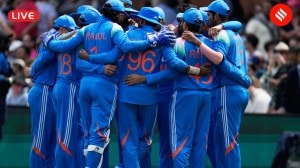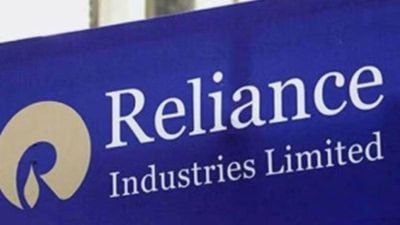Cutting down time, coastal road to change the way Mumbai commutes
9.5 km of the 10.58-km high speed corridor to open for traffic tomorrow
 Workers do the last-minute preparations. (Express Photo by Sankhadeep Banerjee)
Workers do the last-minute preparations. (Express Photo by Sankhadeep Banerjee)Nearly 12 years after the project was conceived, the Mumbai Coastal Road Project (MCRP) — officially Dharmveer Swarajya Rakshak Chhatrapati Sambhaji Maharaj Coastal Road — will be partially inaugurated on Monday. Chief Minister Eknath Shinde along with Deputy Chief Ministers Devendra Fadnavis and Ajit Pawar will inaugurate the road on Monday, after which the south-bound arm and 9.5 kilometres of the 10.58-km high speed corridor of the coastal road will be opened to traffic Tuesday morning.
“The South-bound arm of the MCRP will become operational from 8 am on Tuesday, allowing vehicular movement between Worli and Marine Drive. The road will be open for traffic movement only between 8 am and 8 pm on weekdays since 15 per cent of the work is still left. The work will be carried out at night and on the weekends,” said an official privy to the developments.
While the first phase of the project comprises a 10.58-km stretch, only 9.5 km will be operational, following the Monday inauguration, as the remaining one-kilometre stretch that will connect the road with the Bandra Worli Sea Link (BWSL) comprises a bridge, whose construction is still underway. Only one arm of each of the three interchanges — at Haji Ali, Worli and Amarsons — will be made operational in the initial phase.
For a linear city like Mumbai, where most of the travelling happens in the north-south directions, the MCRP was proposed as an alternative to the existing Western Express Highway (WEH) to improve the north-south connectivity in Mumbai.
Built at a cost of Rs 13,983 crore, the MCRP includes a series of arterial roads along with underground tunnels and bridges, all aiming to decongest the traffic.
Cutting down time
At present, a commute between Worli and Marine Drive under normal traffic conditions during the daytime takes 35 to 40 minutes, while the coastal road will cut it to under 10 minutes.
The key highlight of the 10.58-km long corridor is the 2.07-km twin tunnel, which is partly under the sea and a hill. The tunnels start between the Hindu and Islam Gymkhana, extend north under the Arabian Sea, Girgaon Chowpatty and Malabar Hill, and end at Breach Candy’s Priyadarshini Park.
During its exclusive drive through the tunnel in January, The Indian Express reached Breach Candy to Marine Lines in 3 minutes and 20 seconds. It marks a significant cut from the current travel time between the two locations, which can take at least 30 minutes and requires motorists to cross seven traffic signals.
While the maximum speed for vehicles driving through the undersea tunnels is capped at 60 kilometre per hour (kmph), the speed limit throughout maximum portions of the coastal corridor has been fixed at 80 kmph.
At the three traffic interchanges at Worli, Haji Ali and Amarsons Garden, from where the motorists will be able to switch to the mainland from the carriageway, the speed limit is restricted at 40 kmph.
Even as the civic authorities expect that the travel speeds will be lower in the initial phases, with commuters still getting used to the interchanges, the travel time is slated to reduce significantly.
At present, the average speed on Mumbai’s roads ranges between 21 kmph and 25 kmph during peak hours. According to civic officials, the reduction in traffic congestion would also lead to the improvement of air quality and reduce noise pollution. “Coastal Road will reduce the carbon footprint by about 1826 tonnes of carbon dioxide per annum,” said a data procured from the Brihanmumbai Municipal Corporation.
New open spaces
Alongside decongesting the current route, the project is also adding 70 hectares of open spaces in the city. Of the 111 hectares of land which has been reclaimed to make the coastal road a reality, the civic body has earmarked nearly 70 hectares of land as an open space.
As a part of the 70 hectares, the civic body is developing a 7.5-kilometre long promenade, running along the sea-ward side of the coastal road. In the remainder of the open spaces, the civic body is eyeing to carry out landscaping and greening works on the land-ward side. Meanwhile, the 11-metre median dividing the 20-metre wide main carriageways will also be developed as a green patch.
During an inspection of the site on March 7, CM Shinde said, “We have taken 120 acres of space from Mahalaxmi Race Course and will combine it with the open space that will come up on the coastal road. A grand central park will be constructed on 320 acres and different trees will be planted in an area of 200 acres.” However, these open spaces will not be opened to the public on Tuesday, with the works still underway.
In the pipeline, this year
With the launching of the girders underway, the one kilometre stretch, which marks the remainder of the 10.58 kilometre of MCRP’s first phase and consists of a bow-string bridge — is slated to become operational by the end of May. Once constructed and inaugurated, the road will directly connect to the Bandra Worli Sea Link (BSWL).
While the southbound carriageway will open to traffic on Tuesday, the north-bound carriageway is slated to become operational by May 2024, according to officials. The 20 pedestrian underpasses will also be opened in May, officials said.
In a bid to address parking woes, the civic body is also constructing car parking buildings at locations such as Amarsons, Haji Ali and Worli, with the capacity to accommodate 1,800 vehicles. An official said, “However, this facility will take a bit longer to complete. We are eyeing to open this by September, this year.”
The next phase
In the next phase, the BMC will construct the coastal road that will connect Versova with Dahisar in the western suburbs that will be 20.75-kilometre long. Slated to cost Rs 16,621 crore, the BMC in December has issued work orders to six different firms for going ahead with the work. The civic body has set up a six-year deadline for completing this project.
The total project is being divided into six different packages. The package A will cover 4.5 kilometres between Versova and Bangur Nagar (Goregaon), package B will cover 1.66 km between Bangur Nagar and Mindspace (Malad).
The packages C and D include a north and south bound carriageway that will be created between Mindspace and Charkop (Kandivali). Each of these packages would be 3.66 km each.
The package E, that will be 3.78 km will connect Charkop with Gorai and the final package F will be 3.69 km will connect Gorai with Dahisar.







